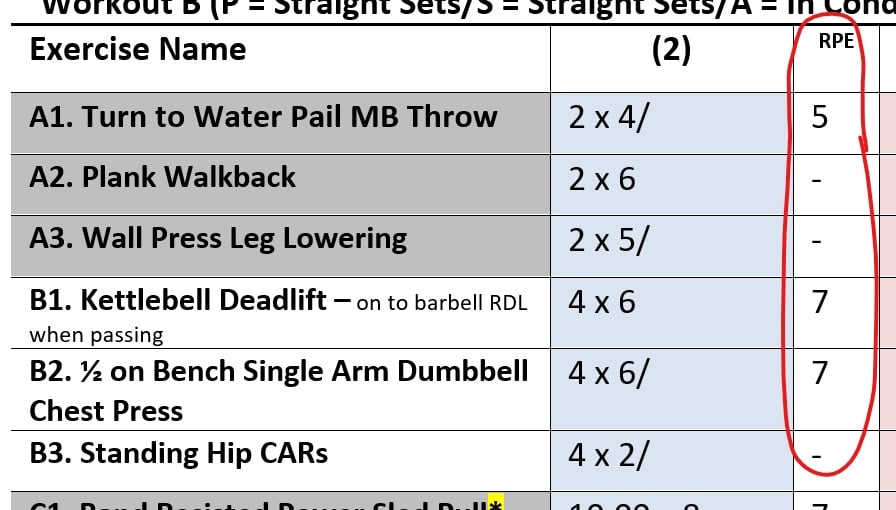Let’s be honest—knowing what weights to use in the gym can be really confusing. Should we test our strength and then build everything off of those numbers? Well, what about the exercises we didn’t test, because we couldn’t possibly test them all, right? Or what if we felt great the day we tested, but crappy on a given day we come in to train—your 75% one day may be your 80% on another…and vice-versa.

With today’s post we’re going to present a better way to select weights: RPE
RPE is something that is used on every single program that we write at BSP NOVA. It’s also something that we teach members from day one, because it helps set them up for success.
RPE stands for “Romanian Pineapple Enchilada.” Kidding, I made that up.
RPE actually stands for “Rating of Perceived Exertion” and is a measure of how hard a set was. It can most easily be thought of as a scale of 1-10, and one in which we primarily program RPE’s of 5 through 9.
RPE: What do all these numbers mean?
- RPE 5: normally reserved for our power training, especially med ball throws, and is a weight that we can easily throw with maximal velocity for all of the prescribed reps
- RPE 6: a weight with which we are able to create maximal velocity with moderate effort
- RPE 7: a weight with which we are able to create maximal velocity with maximal effort for power, or 4-5 quality reps left in the tank for strength training
- RPE 8: hard work, 2-3 quality reps left in the tank
- RPE 9: really hard work, nearing maximal effort, and only 1 quality rep left in the tank
- RPE 10: maximal effort (never in used in our training, reserved for competition), 0 quality reps left in the tank
RPE in Action
When a member finishes a set they would ask themselves,
“how hard did I have to work and how many reps did I have left in the tank?”
By answering this question, they are determining the RPE for that specific set.
Let’s say a member had a rating of perceived exertion of 8 for a deadlift set of 6 reps. If once they finished that set they said, “I felt I could have done 2 more reps,” then that was the right weight choice for that set. If they had said they barely had one more rep in the tank, then it was too heavy. Vice versa, if they said they had “at least 5 more reps” left then it was too light.
Why RPE?
We use RPE on all of our members’ programs because it is a way to adjust their training based on how they feel each day they’re in the gym. If someone comes into BSP NOVA feeling like doo-doo (scientifically speaking), because they are sick and didn’t sleep, then they won’t be able to lift as heavy as before. On the contrary, if they slept well and feel like a million bucks, they can push heavier potentially. Using RPE gives people this flexibility to make intelligent decisions based on the reality of that day.

One day a 96lb kettlebell deadlift might feel like an RPE 7, but on a separate day it feels like a 9. And that’s okay.
It could even change from set to set, and that’s okay, too. You may start with 96lbs feeling like an RPE of 7, but by set 3 it feels like an 9. If your RPE was supposed to be 7-8 and you feel it creeping up towards a 9, then that’s your cue to back off on the weight a little or rest longer so it stays at the set RPE.
Simple, right?
Brutal Honesty

Is this a bit subjective? Absolutely.
One of the most important components of RPE, though, is that you need to be brutally honest with yourself. It will do you no good to lie to yourself about how the set felt. If you’re taking it easy on yourself when you know you could push harder, then you won’t get as much out of that set. If you push beyond the RPE the program calls for your form might break down, only increasing your risk of injury.
RPE is a Skill
RPE is a skill that takes time to master. Learning to gauge the difficulty of a set, to be honest with how it felt, and to prescribe an appropriate RPE number, takes time. Just like any other skill, it takes lots of repetitions to become proficient.
This is part of the reason the coaches here will ask you a question like,
“on a scale of 1-10, with 10 being really hard, how would you rate that set?”
It’s a question that’s asking you to determine the difficulty of the set, yes, but also, it’s giving you a chance to practice the skill of determining your RPE.
Although becoming skilled at using RPE takes time, it is well worth the investment. By making intelligent decisions based on how you feel in that moment, according to the set RPE, you will get the most possible benefit out of each session. So, next time you finish a set, ask yourself,
“how many reps did I have left in the tank?”
and adjust accordingly.
Want to read some similar posts?
-
The Weights Don’t Always Go Up [click to read]
- If you’ve ever found yourself saying, “Why is it that I lifted this exact weight last week, with no issue at all, and today it feels like there’s a magnet on the floor?!”, this blog is for you. Plus, this will expand on the RPE lesson you just read! 🙂
- If you’ve ever found yourself saying, “Why is it that I lifted this exact weight last week, with no issue at all, and today it feels like there’s a magnet on the floor?!”, this blog is for you. Plus, this will expand on the RPE lesson you just read! 🙂
-
Session Tempo: Moving Slow, Moving Fast [click to read]
- This classic blog is one that every member of BSP NOVA should read. It covers how we organize our weeks of training, including the use of RPE, and how to set goals for approaching each day…
